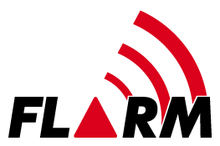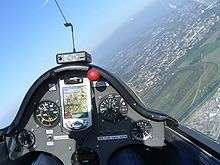FLARM

FLARM is an EASA-approved[1] electronic system used to selectively alert pilots to potential collisions between aircraft. It is not formally an implementation of ADS-B, as it is optimized for the specific needs of light aircraft, not for long-range communication or ATC interaction. FLARM is a portmanteau of "flight" and "alarm".
Operation
FLARM obtains its position and altitude readings from an internal GPS and a barometric sensor and then broadcasts this together with forecast data about the future 3D flight track. At the same time, its receiver listens for other FLARM devices within range and processes the information received. Advanced motion prediction algorithms predict potential conflicts for up to 50 other aircraft and alert the pilot using visual and aural warnings. FLARM has an integrated obstacle collision warning system together with an obstacle database. The database includes both point and segmented obstacles, such as split power lines and cableways.
Unlike conventional transponders, FLARM has low power consumption and is relatively inexpensive to purchase and install. Furthermore, conventional Airborne Collision Avoidance Systems (ACAS) are not effective in preventing light aircraft from colliding with each other as light aircraft can be close to each other without danger of collision. ACAS would issue continuous and unnecessary warnings about all aircraft in the vicinity, whereas FLARM only issues selective warnings about collision risks.
Appraisal and attention
FLARM Technology and the inventors of FLARM have won several awards.[2][3][4][5] The Swiss Office of Civil Aviation (FOCA) also published[6] in Dec 2010: "The rapid distribution of such systems only a few months after their introduction was not accomplished through regulatory measures, but rather on a voluntary basis and as a result of the wish on the part of the involved players to contribute towards the reduction of collision risk. The FOCA recommends that glider tow planes and helicopters that operate in lower airspace should also use collision warning systems."
In addition, FLARM is mandatory in several countries including France,[7] and the Soaring Society of America (SSA) strongly recommends FLARM in lieu of ADS-B Out.[8]
Versions
Versions are sold for use in light aircraft, helicopters, and gliders. Newer PowerFLARM models extend the FLARM range to over 10 km. They also have an integrated ADS-B and transponder Mode-C/S receiver, making it possible to also avoid mid-air collisions with large aircraft.
Newer devices can also act as authorized flight recorders by producing files in the IGC format defined by the FAI Gliding Commission. All FLARM devices can be connected to FLARM displays or compatible avionics (EFIS, moving map, etc.) to give visual and aural warnings and also to show the intruder's position on the map. Licensed manufacturers produce integrated FLARM devices in different avionics products. FLARM devices can issue spoken warnings similar to TCAS.
Protocol
The FLARM radio protocol has always been encrypted to ensure the integrity of the system and also because of privacy and security considerations. Version 4 used in 2008 and Version 6 used in 2015 were hacked despite its encryption.[9] [10]However, FLARM changes the protocol on a regular basis to add functionality and protect security.
The decryption of the FLARM radio protocol is illegal in most countries, including all EU countries. Article 6 of EU Directive 2013/40/EU[11] states that "[...] intercepting, by technical means, non-public transmissions of computer data to, from or within an information system, including electromagnetic emissions from an information system carrying such computer data, intentionally and without right, is punishable as a criminal offence [...]". "Information system" is defined in Article 2 as "a device or group of interconnected or related devices, one or more of which, pursuant to a programme, automatically processes computer data, as well as computer data stored, processed, retrieved or transmitted by that device or group of devices for the purposes of its or their operation, use, protection and maintenance". The Convention on Cybercrime[12] has a similar text in its Article 3. The Convention on Cybercrime has been ratified by most signatory countries.[13]
While the FLARM serial data protocol is public, the prediction engine of FLARM is patented by Onera (France)[14] and proprietary. It is licensed to manufacturers by FLARM Technology in Switzerland.
Company
FLARM was founded by Urs Rothacher and Andrea Schlapbach in 2003, who were later joined by Urban Mäder in 2004.[15] First sales were made in early 2004. Currently there are nearly 30,000 FLARM-compatible devices (around half of them produced by FLARM Technology, the rest by licensed manufacturers who have now overtaken FLARM in current sales) in use mainly in Switzerland, Germany, France, Austria, Italy, UK, the Benelux, Scandinavia, Hungary, Israel, Australia, New Zealand and South Africa.
FLARM's technology is also used in ground-based vehicles including vehicles used in surface-mining. These products are designed and produced by the Swiss company SAFEmine, now being owned by Swedish Hexagon Group.
References
- ↑ PowerFLARM approved by EASA
- ↑ FLARM wins aerokurier Innovation Award
- ↑ FLARM awarded at AERO 2012
- ↑ FLARM wins Prince Alvaro de Orleans Borbon Prize for technical innovation in air sports
- ↑ OSTIV-Prize
- ↑ Safety recommendation
- ↑ FLARM mandatory in France
- ↑ Soaring Society of America (SSA) strongly recommends FLARM in lieu of ADS-B Out
- ↑ FLARM PROTOCOL VERSION 4 (2008)
- ↑ FLARM PROTOCOL VERSION 6 (2015)
- ↑ Directive 2013/40/EU of the European Parliament and of the Council of 12 August 2013 on attacks against information systems
- ↑ Convention on Cybercrime CETS No.185
- ↑ Chart of signatures and ratifications of Treaty 185
- ↑ US patent 6438492, Claude Le Tallec & Boris Gravier, "Device for improving the security of aircraft in visual flight regime", issued August 20, 2002, assigned to Onera
- ↑ FLARM Company History
External links
| Wikimedia Commons has media related to FLARM. |
- Official website
- System Design and Compatibility
- Overview of collision avoidance systems
- Comparison of Mode A/C, S, FLARM and ADS-B
- Enhancing the efficacy of Flarm radio communication protocol by computer simulation (English, German)
- Interview with Gerhard Wesp, Development Manager Avionics at Flarm Technology GmbH, March 2014
